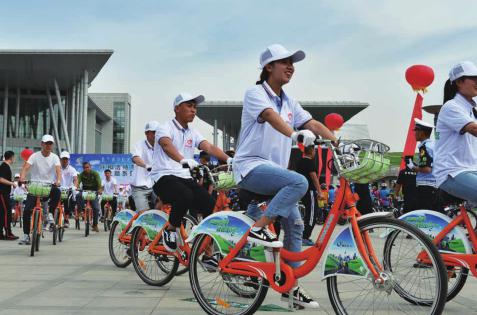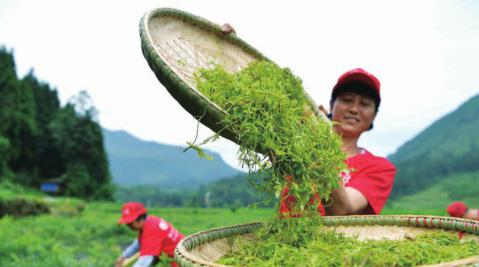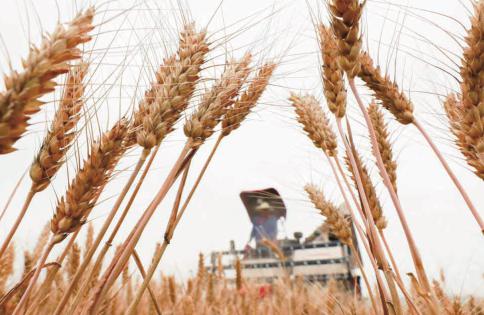Lucky Gesture
2018-07-02

Students pose for a lucky gesture at No.1 High School in Handan City, north Chinas Hebei Province, on June 7. About 9.75 million students sat for the national college entrance examination, which took place on June 7-8.
Conservation Boost
Southwest Chinas Tibet Autonomous Region spent more than 1.1 billion yuan ($172 million) on ecological conservation projects in 2017, the regions environmental protection bureau said on June 5.
The projects ranged from grassland, wetland and wildlife protection to construction of nature reserves and afforestation.
In 2009, China introduced a 23-year plan with a total spending of 15.5 billion yuan ($2.42 billion) to boost ecological conservation in the region.
Statistics showed that in 2017, Tibet had 47 nature reserves covering 412,200 square km, or more than one third of the regions total territory.
Zhang Tianhua, deputy head of the local environmental protection bureau, said Tibet set up a special committee for monitoring the environment and cracking down on illegal activities in the nature reserves.
Over the past fi ve years, more than 60 regulations on ecological protection have been introduced in Tibet, while authorities investigated nearly 1,000 cases of environmental breaches.
Drug Testing Hair
Chinas health department will promote a method which uses hair instead of blood or urine samples to test for drug use, according to developers of the test.
Southwest Chinas Yunnan Province borders the notorious drug production region known as the Golden Triangle in Southeast Asia and is a major front in Chinas battle against drug crime.
The Yunnan Institute for Drug Abuse said it conducted the new test on 100 people, who were new arrivals at the provincial rehabilitation center.
Wen Pinyuan, Director of the institute under the provincial health department, said the test showed 93 percent were morphine or methamphetamine positive, matching urine drug tests done on the same group.
“Compared to blood and urine samples, hair samples have the advantage of being more stable, easier to obtain and preserve,” Wen said.
He noted that hair samples can preserve drug residue for weeks or even months, giving drug enforcement offi cers a larger window to confi rm drug use.
In the fi rst quarter of this year, Yunnan police seized 5,759.7 kg of drugs, up 31.4 percent year on year. Over 12,000 drug users were placed in mandatory rehabilitation programs during the same period, local authorities said.
Wen added that the institute will continue to optimize the use of the new testing technology, making it more accurate, feasible and economical.
Passenger Transport Safety
China released a management guideline to supervise passenger transport companies on safety issues and reducing risks.
The guideline was jointly published recently by the Ministry of Transport, the Ministry of Public Security and the Ministry of Emergency Management.
The guideline details rules focusing on safety education, risk management and control and examination of hidden dangers.
Data shows that 55.8 percent of road accidents that caused more than 10 deaths from 2012 to 2017 involved passenger vehicles and tour coaches.
Many of the accidents were caused by irresponsible companies which did not carry out safety checks.
Car Emissions
Automobile emissions have become a major source of air pollution in China and need to be handled properly, according to a recent report.
China remained the worlds largest automobile market last year, with about 310 million vehicles, up 5.1 percent year on year, according to the report released by the Ministry of Ecology and Environment (MEE).
Some cities saw increasing air pollution due to a combination of coal burning and vehicle exhaust emissions. Studies of the cause of pollution in Beijing, Tianjin, Shanghai and another 12 Chinese cities found that vehicle exhaust emissions contributed from 13.5 percent to 52.1 percent of major pollutants.
The MEE will speed up drafting an action plan to deal with diesel-powered trucks, which are considered to be a major air polluter, it said in a statement.
It will also develop the strictest environmental regulation mechanism for vehicle exhaust emissions and promote clean diesel-powered vehicles and green transportation, the statement added.
Tourism Supervision
China will put into use a platform to regulate and supervise the tourism industry starting on July 1, the Ministry of Culture and Tourism said on June 1.
The platform covers functions such as examining travel agenciesqualifi cations, managing tour guides, and dealing with complaints from consumers, among others.
Travelers can get information about tour guides and make comments on their services through the platform, which can also detect unreasonable prices in the market through e-contracts.
Tourism is thriving in China. Data showed the countrys domestic tourism industry brought in 4.57 trillion yuan ($725.4 billion) last year, up 15.9 percent year on year.
Healthy Life Span
Chinese people can look forward to a longer healthy life than people in the United States for the fi rst time since records began, according to World Health Organization (WHO) data.
Chinese babies born in 2016 can expect 68.7 years of healthy life, compared with 68.5 years for U.S. babies, the fi gures show.
U.S. newborns can still expect to live longer overall, 78.5 years, compared to Chinas 76.4. But during the last decade people from the United States have suffered from bad health.
The United States was one of fi ve nations, along with Somalia, Afghanistan, Georgia and Saint Vincent and the Grenadines, where healthy life spans beginning at birth fell in 2016, according to the data, which was published in mid-May.
“Chinese life expectancy has increased substantially and is now higher than for some high-income countries,” said WHO spokesperson Alison Clements-Hunt.
U.S. life span is decreasing, having peaked at 79 years in 2014, the fi rst such reversal for many years, she said.
The worlds longest living people are the Japanese. Babies born in Japan in 2016 were forecast to live for 84.2 years.
Spectacular Landscape
Tourists visit the Huangguoshu Waterfall in Anshun City, southwest Chinas Guizhou Province, on June 5. The waterfall entered into a period of high fl ow due to continuous rainfall.
Tuberculosis Treatment
Chinas tuberculosis incidence rate fell to 60.5 per 100,000 people in 2017, and the countrys tuberculosis prevention and treatment is better than the world average, according to the National Health Commission.
“The countrys incidence rate of tuberculosis in 2017 dropped by 14.3 percent from 2012, with the annual drop around 3 percent, obviously faster than the world average,” said Mao Qunan, head of the Disease Control and Prevention Division of the commission.
The mortality rate of tuberculosis was 2.8 per 100,000 people in China in 2017, comparable to that of developed countries, Mao said.
Noting that China has laid out anti-tuberculosis plans to address different phases of the disease, Mao said the fund for preventing and treating the disease has risen from 260 million yuan ($41 million) in 2004 to 640 million yuan ($100 million) in 2017.
“Authorities have promoted education about tuberculosis and screening of the disease among the public,” Mao said. “At present, there are more than 700,000 antituberculosis volunteers.”
Ecolife
Volunteers ride bicycles promote green travel in Hohhot, capital of north Chinas Inner Mongolia Autonomous Region, on World Environment Day on June 5.
Private Railway
East Chinas Zhejiang Province has granted permission for the countrys fi rst high-speed railway project undertaken by private investors, said the provincial economic planner on June 5.
The railway, 226.56 km long and capable of a maximum speed of 350 km per hour, is an intraprovincial route connecting the cities of Shaoxing and Taizhou.
The project is to be jointly funded by private capital led by Fosun Group, state-owned China Railway, the Zhejiang Communications Investment Group Co. Ltd. and the local government.
Private capital will hold a 51-percent stake in the railway, whose planned investment totals 44.9 billion yuan ($7.01 billion).
Fosun Group signed an agreement on the project with the Zhejiang Provincial Government in September 2017, with the railway expected to be completed in 2021.
Belt and Road Opportunities
Economic opportunities along the routes of the China-proposed Silk Road Economic Belt and 21stCentury Maritime Silk Road are expected to increase this year as more Chinese fi rms step up overseas expansion, a report from global audit and consultant fi rm Deloitte showed.
The Belt and Road Initiative is writing a new chapter for investment and trade, with a strong performance in 2017, while Deloitte believes the initiative will increase in signifi cance in 2018.
“A growing number of countries and organizations are actively involved in the initiative, promoting its development across the globe. The initiative now looks beyond infrastructure projects, expanding to other diverse industries and sectors in destination countries,” said Norman Sze, Belt and Road Services China leader with Deloitte.
While Chinas state-owned enterprises took the lead in the initiatives early stage, more private and foreign-funded companies are taking part. Meanwhile, traditional and emerging industries are expected to see new opportunities in international industrial capacity cooperation, he said.
“The Belt and Road Initiative is shaking off geographical limitations and creating a new platform for winwin results through discussion and collaboration,” Sze added.
The report estimated that Internet companies, led by Baidu, Alibaba and Tencent, will play a key role in outbound investment, transforming Made in China from cheap commodities to innovative products.
Projects in areas like artifi cial intelligence and biotechnology, which focus on technological innovation, are to be heavily favored, the report showed.
A Woven Masterpiece
A visitor photographs a carpet at the International Carpet Exposition held in Xining, northwest Chinas Qinghai Province, on June 2.
The fi ve-day event attracted over 650 businesses from home and abroad to come and display their latest products.
Growth Forecasts
The World Bank upgraded its forecast for Chinas economic growth in 2018 to 6.5 percent, 0.1 of a percentage point higher than its January forecast. But growth is estimated to edge down to 6.3 percent in 2019, as regulatory and macro-prudential policies tighten and fi scal policy becomes less accommodating.
In its Global Economic Prospects report released on June 5, the World Banks growth forecast for the global economy remains unchanged for this year and the next, but it has warned of a combination of considerable risks including escalating trade protectionism.
The report said the global economy would grow 3.1 percent in 2018 before slowing to 3 percent in 2019, unchanged from its previous forecasts in January.
Growth in advanced economies is expected to moderate slightly to 2.2 percent in 2018 and slow further to 2 percent next year as central banks gradually remove monetary stimulus, according to the report.
Growth in emerging markets and developing economies is predicted to strengthen to 4.5 percent in 2018 before reaching 4.7 percent in 2019, as “the recovery in commodity exporters matures and commodity prices level off following this years increase.”
Tea Time
A farmer sorts tea leaves at a production base in Xianfeng County, central Chinas Hubei Province, on June 5.
Copper Investment
On June 1, the Aluminum Corp. of China (Chinalco) announced plans to invest $1.3 billion to expand its operations at Perus Toromocho copper mine.
The decision aims to boost the companys capacity to produce and process fi ne copper, Chinalcos CEO Ge Hongling said during a meeting with Peruvian President Martin Vizcarra in Lima.
“By 2020, the annual production capacity will increase 45 percent and the value of annual output will reach $2 billion, contributing to the creation of more jobs and tax,” Ge said.
Chinalco, which has been operating in Peru for 10 years, hopes to triple its processing capacity to 157,000 tons a day and to double its annual output of fi ne copper to 300,000 tons.
Vizcarra welcomed Chinalcos“signifi cant” investment, saying it will help spur Perus economy, raise revenue and support government education and healthcare programs.
Geological studies show Toromocho, located about 150 km east of Lima, contains more than 1.52 billion tons of minerals with an average copper content of 0.48 percent, along with molybdenum and silver. Chinese Ambassador to Peru Jia Guide told reporters at a press conference that “over the next three years, we expect a wave of Chinese investment in Peru of some $10 billion in energy, mines, construction and fi nance.”
Better Service Quality
The quality of Chinas service sector improved last year, according to a new offi cial report.
The customer satisfaction index rose 2.86 points from 2016 to 74.75 out of 100 in 2017, remaining“relatively satisfactory,” according to a monitoring report from the State Administration for Market Regulation.
Higher scores were given to telecommunications, civil aviation, online payment and online shopping services, the report said.
Customer satisfaction is an important indicator of service quality around the world, as surveys show that higher levels of customer satisfaction are associated with higher returns on investment.
However, the report also showed that the service sector needs distinctive services and better personnel, registering low scores in special services and attitudes toward customers.
The administration said it will work with other departments to draft legislation on supervising service quality and monitoring risks in the sector.
In 2017, the service sector accounted for 51.6 percent of Chinas GDP and contributed 58.8 percent to GDP growth.
Wheat From the Chaff
A farmer harvests wheat in Jian Village, Huaian City, east Chinas Jiangsu Province, on June 6.
IPR Protection
China has achieved signifi cant results in the protection of intellectual property rights (IPR), according to the State Intellectual Property Offi ce.
Shen Changyu, head of the offi ce, made the remarks at a forum in Beijing on June 5 to evaluate the countrys IPR achievements since 2008 when a national IPR strategy was unveiled.
“China will accelerate the modernization of its IPR governance system and ability and further promote the application and trans- formation of intellectual property to create more social benefi ts,” Shen said,
In 2017, China saw 1.38 million patent applications for inventions, up by 14.2 percent from 2016 and the highest in seven years.
Tightened Regulation
The Chinese Government has moved to tighten regulation of drivers and platforms offering ride-hailing services, vowing to crack down on illegal activity and irregularities such as unlicensed services, privacy leaks and unfair competition.
In a joint statement issued on June 5, the Ministry of Transport and six other ministries said they will launch joint supervision of the ridehailing industry, both for in-progress rides and after-journey services.
Ride-hailing platforms who fail to address irregularities will be forced to suspend their services or their mobile apps will be removed from online stores according to relevant laws and regulations.
China unveiled its fi rst nationwide regulations for car-hailing services in July 2016, granting legal status to the industry.
